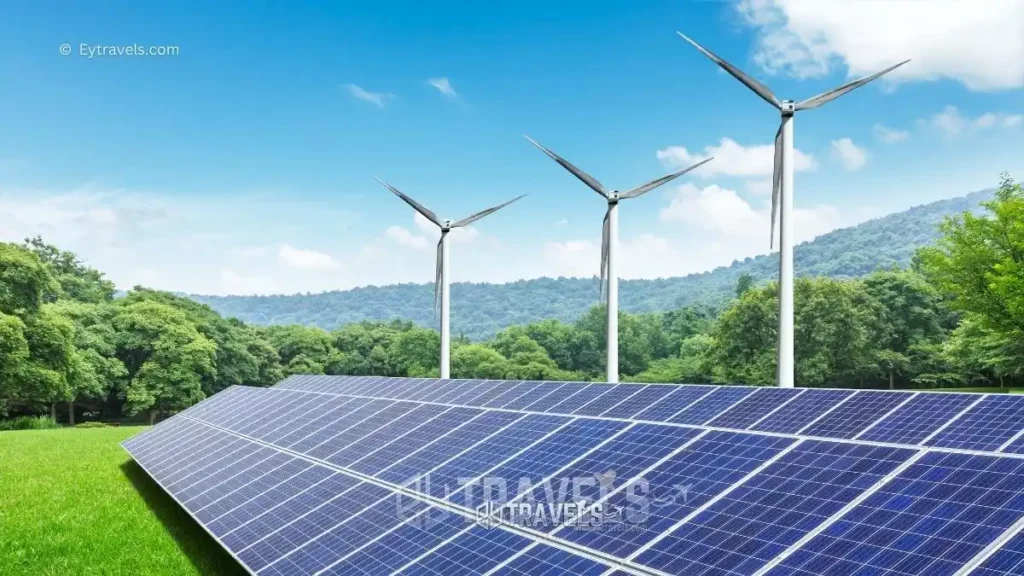The Green Economy, an amalgamation of environmental sustainability and economic viability, has evolved into a pivotal concept reshaping our global trajectory. Its definition encapsulates a harmonious blend of resource conservation and economic growth, laying the foundation for a resilient future.
Key Principles of the Green Economy
Sustainability as the Core Pillar
Sustainability, the linchpin of the green economy, manifests through resource efficiency and circular economy practices. Maximizing the utility of resources and minimizing waste become imperative in a world aiming for longevity.
Resource Efficiency
Efficiency in resource usage entails optimizing raw materials, reducing energy consumption, and employing innovative technologies. Industries adopting resource efficiency not only contribute to environmental conservation but also enhance their operational effectiveness.
Circular Economy Practices
A shift towards circular economy practices emphasizes the importance of closing the loop in product lifecycles. Recycling, reusing, and reducing waste become paramount strategies, mitigating the ecological impact of production and consumption.
Social Equity and Inclusivity
The green economy extends beyond environmental considerations, embracing social equity and inclusivity as core tenets.
Fair Labor Practices
Ensuring fair wages and humane working conditions within the green economy creates a holistic approach to sustainability. Ethical treatment of laborers becomes as crucial as the environmental aspects.
Community Engagement
Inclusivity spreads to communities, involving them in decision-making processes and acknowledging the cultural significance of sustainability initiatives. The green economy becomes a communal effort, fostering a sense of shared responsibility.
Sectors Driving the Green Economy
Renewable Energy

Within the dynamic framework of the green economy, the significance of renewable energy sources, exemplified by the likes of solar power and wind energy, cannot be emphasized enough. These sustainable powerhouses play a pivotal and irreplaceable role in reshaping our approach to energy consumption and production, ushering in an era of unparalleled environmental stewardship.
As we navigate the transition towards a more sustainable future, it becomes increasingly apparent that the integration of solar and wind energy is not just a choice but a necessity. These renewable marvels, with their ability to harness the inexhaustible power of the sun and the ceaseless motion of the wind, stand as beacons of innovation and hope in our quest for cleaner, greener energy alternatives.
In the tapestry of the green economy, solar panels glinting in the sunlight and majestic wind turbines turning with the breeze become symbolic threads, weaving a narrative of progress and responsibility. Beyond their role in reducing carbon footprints, these sources of renewable energy become catalysts for economic growth, driving innovation, creating jobs, and fostering resilience in the face of climate challenges.
In essence, the profound impact of solar power and wind energy extends beyond mere technological advancements; it represents a transformative force, reshaping the energy landscape and propelling us towards a future where sustainability and progress walk hand in hand.
Solar Power
Solar power harnesses the sun's energy, offering a clean and renewable alternative to traditional energy sources. Advancements in solar technologies continually enhance efficiency, making it an increasingly viable energy option.
Wind Energy
Wind energy capitalizes on the power of wind to generate electricity. As technology improves, wind farms become more efficient, providing a sustainable solution to the global energy demand.
Sustainable Agriculture
The agricultural sector plays a significant role in the green economy, with sustainable practices reshaping the way we produce food.
Organic Farming Practices
Organic farming eliminates synthetic pesticides and fertilizers, prioritizing soil health and biodiversity. The shift towards organic practices not only benefits the environment but also produces healthier food options.
Agroecology
Agroecology integrates ecological principles into agricultural systems, promoting biodiversity and reducing the ecological footprint of farming. This holistic approach enhances resilience against environmental challenges.
What is green economy? Policies and Regulations
International Frameworks
Global efforts, such as the Paris Agreement and Sustainable Development Goals (SDGs), set the stage for unified action towards a sustainable future.
Paris Agreement
The Paris Agreement, a landmark accord, aims to limit global temperature rise and adapt to the impacts of climate change. Nations committing to this agreement demonstrate a collective responsibility towards environmental stewardship.
Sustainable Development Goals (SDGs)
The United Nations' SDGs provide a comprehensive roadmap for global sustainable development. These goals address a range of issues, from poverty alleviation to clean energy, fostering a holistic approach to global challenges.
National Initiatives
Individual nations contribute to the green economy through government incentives and regulatory measures.
Government Incentives
Governments play a crucial role in incentivizing sustainable practices. Financial incentives and tax breaks encourage businesses to adopt environmentally friendly measures, fostering a green-friendly economic landscape.
Regulatory Measures
Enforcing regulations that limit environmental impact ensures that industries adhere to sustainable standards. These measures create a level playing field and set a baseline for responsible business practices.
Economic Benefits of Green Practices
Job Creation
The profound impact of the green economy extends far beyond its environmental benefits—it stands as a formidable catalyst for substantial job creation, unleashing a tidal wave of opportunities that ripple across a myriad of sectors.
As sustainable practices become increasingly integral to our societal fabric, the burgeoning green economy not only champions ecological well-being but also emerges as a robust engine propelling employment growth. In this dynamic landscape, the landscape of job prospects flourishes, providing a fertile ground for individuals to explore and harness their talents across diverse and expanding sectors.
The green economy, with its roots firmly planted in sustainability, not only nurtures a healthier planet but also cultivates a thriving ecosystem of employment possibilities, shaping a future where ecological responsibility and economic prosperity coalesce harmoniously.
Green Job Profiles
Emerging job profiles, from renewable energy technicians to sustainability consultants, define the green job landscape. These roles not only offer employment but also drive expertise in sustainable practices.
Economic Impact Analysis
Beyond job creation, the green economy stimulates economic growth. Analyzing the economic impact of sustainable practices reveals a positive correlation between environmental responsibility and financial prosperity.
Cost Savings and Long-Term Investments
Investing in green practices proves economically beneficial in the long run, offering both cost savings and sustainable financial growth.
ROI in Sustainable Practices
Companies investing in sustainability experience a return on investment through reduced operational costs and increased market appeal. Sustainable practices translate into long-term financial resilience.
Avoiding Environmental Externalities
The cost of environmental damage often goes unnoticed. Green practices mitigate these externalities, preventing long-term ecological and financial repercussions.
Challenges and Criticisms
Greenwashing Concerns
Despite the noble aspirations of the green economy, concerns arise regarding greenwashing—misleading claims of sustainability.
Identifying Genuine Efforts
Distinguishing authentic green initiatives from mere marketing strategies becomes essential. Transparent reporting and standardized certifications aid consumers and investors in making informed choices.
Transparency in Reporting
Companies must embrace transparency in reporting their sustainability efforts. Open communication builds trust and holds businesses accountable for their environmental claims.
Economic Viability
Balancing profit motives with sustainability goals poses a challenge for industries navigating the transition towards green practices.
Balancing Profit and Sustainability
Striking a balance between profitability and sustainability requires strategic planning. Businesses must align economic objectives with environmental responsibility to ensure a sustainable future.
Transitioning Challenges for Industries
Industries accustomed to traditional practices face hurdles in transitioning to sustainable models. Supportive policies and collaborative efforts can ease this transition, ensuring long-term success.
green economy Innovations and Technologies
Technological Advancements
Innovations in technology play a pivotal role in driving the green economy forward.
Smart Grids
Smart grids optimize energy distribution, enhancing efficiency and reducing wastage. The integration of technology into energy systems aligns with the green economy's focus on resource efficiency.
Sustainable Materials
The development of sustainable materials, from bioplastics to eco-friendly construction materials, transforms industries. Technological advancements pave the way for eco-conscious alternatives, reducing reliance on resource-intensive materials.
Case Studies
Successful Green Economy Models
Examining successful green economy models provides insights into practical implementation strategies.
Scandinavian Countries
Nations like Sweden and Denmark exemplify successful green economies. Their comprehensive approach, from renewable energy adoption to sustainable urban planning, sets a benchmark for global sustainability.
Corporate Success Stories
Companies leading the way in sustainable practices showcase the economic viability of green initiatives. From eco-friendly product lines to carbon-neutral operations, these success stories inspire widespread adoption.
Public Awareness and Education
Importance of Environmental Literacy
Public awareness and education form the cornerstone of the green economy's success.
Educational Programs
Incorporating environmental education into academic curricula fosters a generation that values sustainability. Educational programs at all levels contribute to building an environmentally conscious society.
Media Influence
Media plays a crucial role in shaping public perception. Responsible journalism and media campaigns contribute to informed decision-making, encouraging individuals to support green initiatives.
Future Trends in the Green Economy
Emerging Technologies
The future of the green economy lies in the integration of emerging technologies.
AI in Sustainability
Artificial intelligence enhances sustainability efforts through data analysis, predictive modeling, and automation. AI-driven solutions optimize resource usage and provide innovative solutions to environmental challenges.
Bioenergy and Biotechnology
Advancements in bioenergy and biotechnology offer sustainable alternatives to traditional practices. From biofuel production to biodegradable materials, these technologies pave the way for a greener future.
Global Collaboration
International Cooperation
Global challenges require global solutions, emphasizing the need for international collaboration.
Cross-Border Initiatives
Collaborative initiatives between nations foster knowledge exchange and shared responsibility. Global agreements and partnerships contribute to a unified approach to addressing environmental issues.
Knowledge Sharing
Sharing best practices and lessons learned on a global scale accelerates progress. International forums and collaborative platforms create a collective pool of knowledge, driving continuous improvement.
Critique and Continuous Improvement
Feedback Mechanisms
Establishing feedback mechanisms allows for constant evaluation and improvement.
Adapting to Criticisms
Acknowledging critiques and adapting strategies based on constructive feedback ensures the effectiveness of green initiatives. A culture of continuous improvement strengthens the resilience of the green economy.
The Role of Stakeholders
Involving stakeholders, from communities to businesses, in decision-making processes fosters a sense of shared responsibility. Engaged stakeholders contribute diverse perspectives, enriching the green economy's evolution.
Recap
The green economy, a dynamic intersection of environmental responsibility and economic prosperity, stands as a testament to humanity's capacity for positive change.
Individuals, businesses, and nations each play a crucial role in shaping the green economy. Embracing sustainable practices and contributing to the collective effort ensures a future where prosperity coexists with environmental stewardship.







🌿✈️ Explore the fascinating world of the Green Economy with EyTravels!
🌎 Learn about sustainability, renewable energy, and how it shapes our future at https://www.eytravels.com/what-is-green-economy/ 📚
🌐 Follow, like, and join the #eytravels journey for more insights!
.
.
.
#GreenEconomy #Sustainability #RenewableEnergy #FutureTrends #GlobalCollaboration #EcoFriendly #TravelWithPurpose 🌟